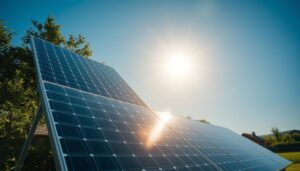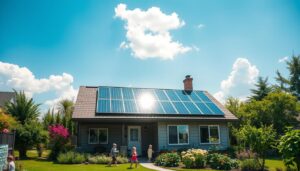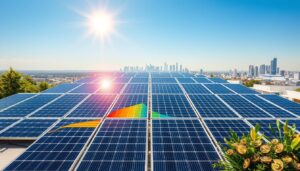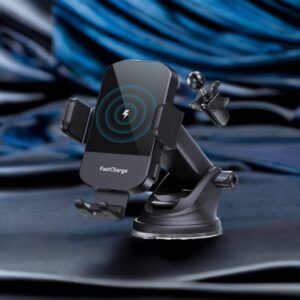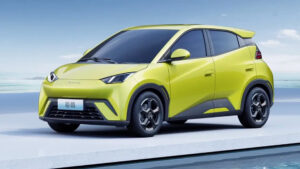
Did you know the global solar photovoltaic (PV) market is set to hit $290.8 billion by 2028? It’s growing at a whopping 20.5% CAGR. This shows how fast renewable energy solutions are becoming popular. Solar electric generators are leading this change, making clean, reliable power for our homes and businesses.
Solar electric generators, or portable solar power systems, are at the core of this change. They turn sunlight into electricity we can use anytime, anywhere. They’re great for powering off-grid cabins, charging RVs on trips, or as a backup for homes. They’re a green, practical choice that’s catching on worldwide.
Key Takeaways
- The global solar photovoltaic (PV) market is projected to reach $290.8 billion by 2028, growing at a CAGR of 20.5%.
- Solar electric generators offer a clean, reliable, and sustainable alternative to traditional electricity sources.
- These versatile systems can power homes, businesses, and outdoor activities, making them a practical solution for a wide range of applications.
- The growing demand for renewable energy solutions is driving the rapid adoption of solar electric generators worldwide.
- Solar electric generators are a key component in the global shift towards a more sustainable energy future.
Understanding Solar Electric Generators: A Complete Overview
Solar electric generators, or photovoltaic energy generators, use the sun’s power to make electricity. They are changing how we get power, making it clean and green. This is a big step towards a more sustainable future.
Basic Components and Functionality
The core of a solar electric generator is the solar panels. These panels have photovoltaic cells that turn sunlight into electricity. They are set up to catch the most sunlight possible.
The electricity made is stored in big batteries. An inverter then changes it into the kind of electricity that can power your home or gadgets.
How Solar Generation Works
The magic of solar electric generators happens in the photovoltaic process. Sunlight hits the panels, and the photovoltaic cells grab the photons. This makes the electrons move, creating electricity.
The more sunlight the panels get, the more electricity they make. This makes solar power a clean and dependable energy source.
Key Benefits at a Glance
- Reduced carbon footprint – Solar electric generators make clean energy without the bad stuff from fossil fuels.
- Energy independence – They let people make their own power, cutting down on grid use and giving more control.
- Cost savings – Even though they cost more upfront, they save money on bills over time. Plus, there are tax breaks and rebates.
The Evolution of Portable Solar Power Systems
The world of portable solar power has changed a lot over time. What was once big and not very good has turned into sleek, strong systems. These portable solar generators are changing how we get clean energy.
At first, portable solar power systems could only charge small devices. But now, thanks to new tech, they can power many things. This includes camping, RVing, and even helping in emergencies.
What’s behind this big change? It’s the better solar panels, batteries, and designs. New solar panels are light but pack a lot of power. Batteries now last longer and charge faster, making portable solar generators great for off-grid use.
Now, there are many portable solar generators for different needs. You can find tough ones for the outdoors or sleek ones for home use. This variety makes portable solar generators a popular choice for green, reliable power.
| Feature | Early Portable Solar Generators | Modern Portable Solar Generators |
|---|---|---|
| Power Output | Low, limited to small electronics | High, capable of powering a range of devices and appliances |
| Size and Weight | Bulky and heavy | Compact and lightweight, easy to transport |
| Battery Capacity | Limited, with short runtime | Increased capacity, allowing for longer runtime |
| Charging Time | Slow, often taking several hours | Faster, with efficient charging technologies |
The portable solar generator world is getting even better. We’ll see more advanced, easy-to-use systems soon. The future of portable solar power is very promising.
Essential Components of Solar Electric Generator Systems
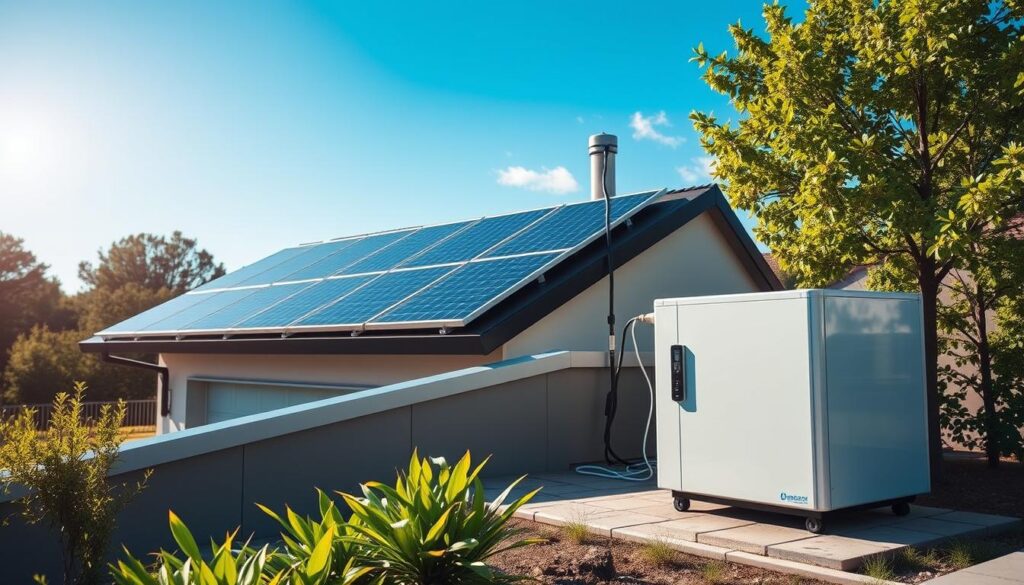
The sun’s power is harnessed by key parts of a solar electric generator system. Solar panels catch the sun’s rays, and batteries store the power. Together, they offer a reliable and green electricity source.
Solar Panels and Photovoltaic Cells
Solar panels are at the system’s core. They’re made of photovoltaic cells that turn sunlight into electricity. The quality of these panels affects how much power they produce, with better ones costing more but working harder.
Battery Storage Solutions
Batteries are vital for steady power. You can choose from lithium-ion or lead-acid batteries. Lithium-ion batteries are smaller and more efficient, but lead-acid batteries are cheaper and simpler to care for.
Charge Controllers and Inverters
Charge controllers manage the power flow to batteries, keeping them safe and charged well. Inverters change the DC power from panels to AC for home use.
Knowing about these parts helps you pick the right solar battery backups or photovoltaic energy generators for your needs.
Sizing Your Solar Electric Generator for Optimal Performance
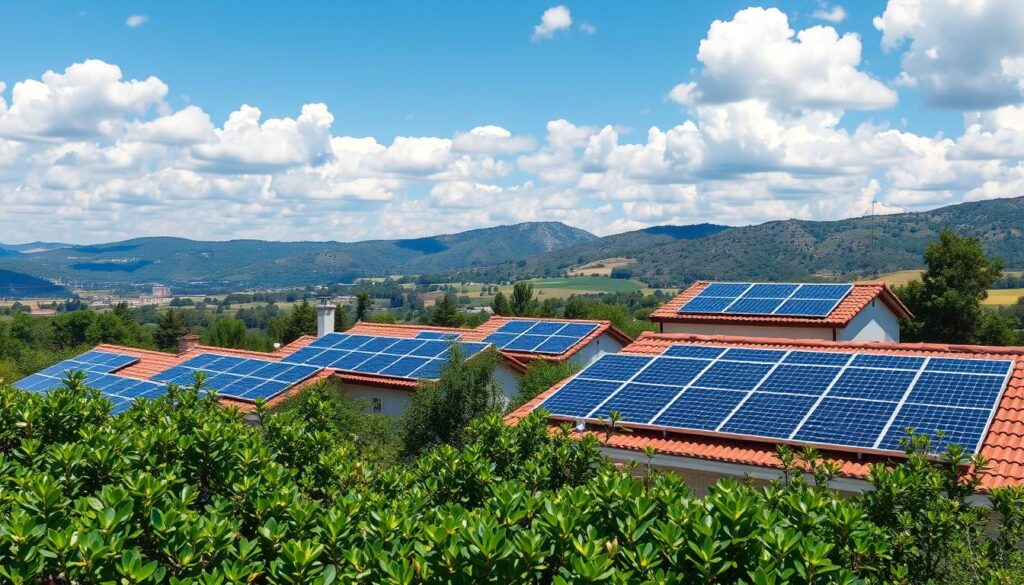
Choosing the right solar electric generator is key. It ensures you get the most out of your solar power system. Several important factors need to be considered when sizing your system.
First, think about how much energy you use every day. What are your daily power requirements? How much electricity do you need to run your essential appliances and devices? Knowing this helps you pick a solar generator that fits your needs.
- Determine your total daily energy usage in kilowatt-hours (kWh).
- Think about any future energy needs, like adding more devices or expanding your setup.
- Choose a solar generator with enough power to meet your current and future needs.
Also, consider how much space you have for your solar panels. The size and placement of your panels affect how much power you can generate. Make sure you have enough room for the panels you need.
| Solar Generator Size | Recommended Panel Capacity | Typical Use Cases |
|---|---|---|
| 500-1000 watts | 300-600 watts | Recreational vehicles, small homes, and emergency backup power |
| 1000-3000 watts | 600-1800 watts | Mid-sized homes, small businesses, and larger recreational vehicles |
| 3000+ watts | 1800+ watts | Large homes, commercial buildings, and off-grid applications |
By thinking about your energy needs, available space, and future plans, you can find the best solar electric generator. It will power your home, business, or outdoor activities efficiently and sustainably.
Installation and Setup Guidelines for Maximum Efficiency
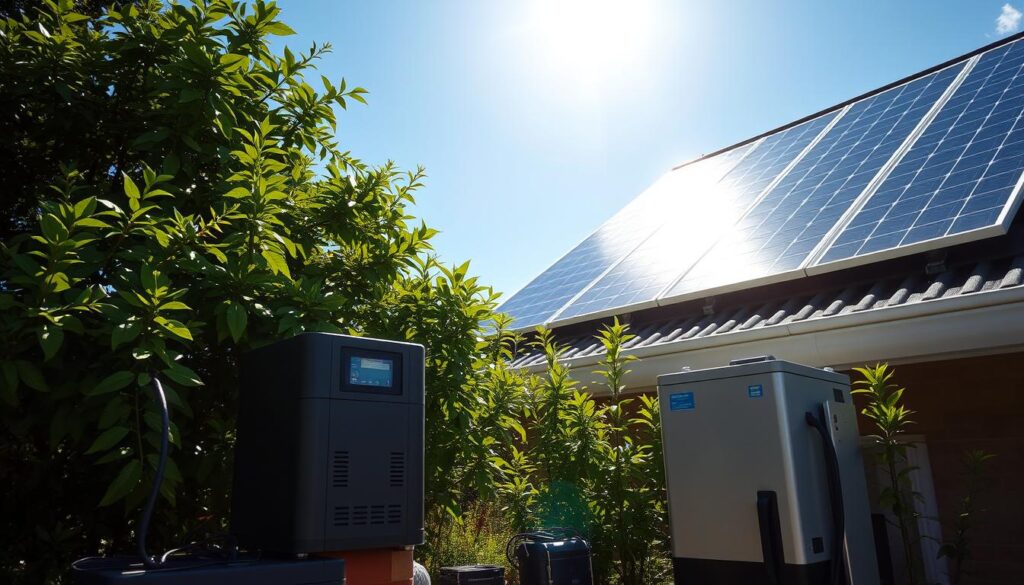
Getting the most out of solar electric generators needs careful planning. The installation and setup are key to their performance. Let’s look at what you need to do to get your system running well.
Site Assessment and Positioning
The first thing is to assess your site. Check the space, the sun’s path, and any shadows that might affect your system. Putting the solar panels in the right spot is vital for good energy output.
Wiring and Connection Basics
After picking your spot, it’s time for wiring and connections. You’ll need to set up the solar panels, connect them to the charge controller, and link the battery. Following local electrical codes and safety rules is important to keep your system safe and working well.
Safety Considerations
When you’re setting up your solar electric generator, safety comes first. Wear the right gear like gloves and safety glasses. Also, keep up with maintenance and checks to spot and fix any problems. This keeps your solar electric generator and renewable energy solutions safe and reliable.
| Key Considerations | Importance |
|---|---|
| Site Assessment and Positioning | Maximizing solar energy capture and system efficiency |
| Wiring and Electrical Connections | Ensuring proper and safe electrical integration |
| Safety Precautions | Protecting both the system and the user from possible dangers |
Following these guidelines will help you get the most from your solar electric generator. You’ll enjoy the clean, green energy it provides.
Maintenance and Long-term Care of Your Solar Power System
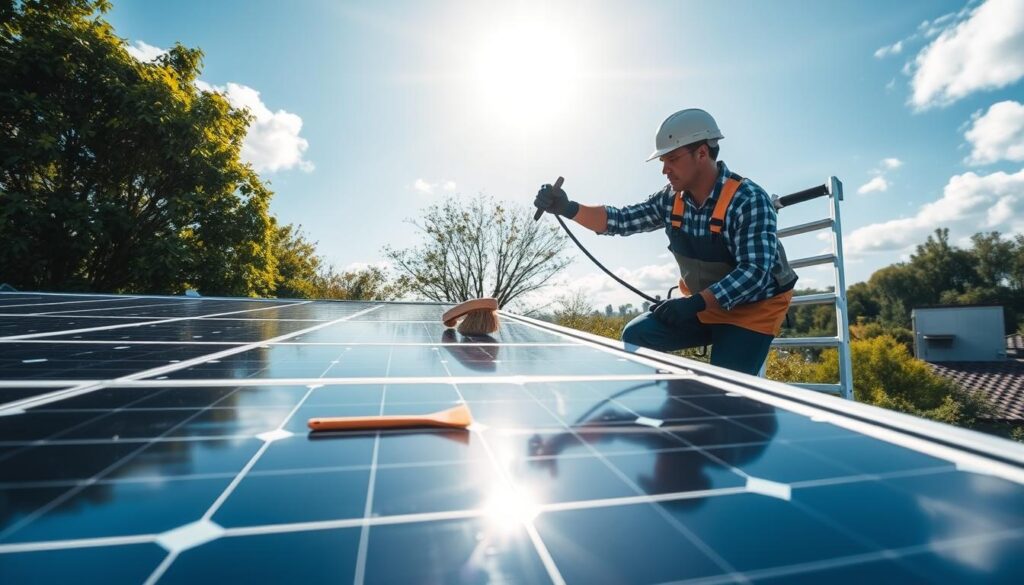
Getting a solar power system is a smart move towards sustainable electricity solutions and less carbon footprint. But, to keep your system running well for many years, you need to take care of it. Here are the important steps to keep your solar power system in great condition.
Routine Maintenance Tasks
Regular upkeep is vital for your solar power system‘s long life and best performance. This includes:
- Cleaning solar panels to get rid of dust, debris, or anything that blocks sunlight.
- Checking and tightening electrical connections to keep power flowing smoothly.
- Looking over the battery bank to make sure it’s charging and discharging right.
- Watching the charge controller and inverter for any signs of trouble.
Maximizing System Lifespan
To make your solar power system last longer, follow these tips:
- Proper siting and positioning of your solar panels for the best sunlight.
- Regularly testing and replacing batteries to keep storage up.
- Keeping your system safe from environmental factors like bad weather, pests, and damage.
- Getting help from pros for big repairs or upgrades to keep your system strong.
By taking good care of your solar power system and following these tips, you can enjoy sustainable electricity solutions for a long time.
Cost Analysis and Return on Investment
Getting a solar electric generator might seem pricey at first. But, the long-term savings and benefits make it a smart choice. It’s important to look at the initial cost, long-term savings, and tax incentives to see if it’s worth it.
Initial Investment Considerations
The cost of a solar electric generator depends on its size, quality, and installation. Prices can range from a few hundred to several thousand dollars. Remember to factor in installation, permits, and upkeep costs too.
Long-term Savings Calculator
The savings over time are key to understanding the value of a solar electric generator. By calculating energy savings, you can figure out when you’ll break even. The cost of electricity, system efficiency, and sun exposure all play a role.
Available Tax Incentives and Rebates
There are many incentives to help with the cost of a solar electric generator. These include tax credits, rebates, and more. By using these, you can lower the system’s cost and boost your return on investment.
| Incentive Type | Savings Potencial |
|---|---|
| Federal Solar Investment Tax Credit (ITC) | Up to 26% of the total system cost |
| State-level Rebates and Tax Credits | Varies by location, but can range from $0.50 to $2.00 per watt |
| Local Utility Incentives | Additional savings through net metering and other programs |
By looking at the initial cost, long-term savings, and incentives, you can decide if a solar electric generator is right for you. It’s a smart, eco-friendly choice for many.
Common Applications and Use Cases
Solar electric generators are becoming more popular. They offer a green and flexible solution for many needs. These off-grid power sources are used in homes, businesses, and for fun activities. They provide power when and where it’s needed.
Homeowners are using portable solar generators as a backup during power outages. They also power remote cabins and RVs. These units are easy to move and set up, keeping your lights and gadgets on.
Businesses like construction sites and outdoor events are also using solar generators. They are a clean and quiet choice compared to gas generators. This reduces harm to the environment and keeps operations running smoothly.
Outdoor lovers and adventurers find solar generators useful too. They can charge devices and power camping gear. This means less need for gas generators while enjoying nature.
Solar generators are also key in emergency situations. They ensure power for essential services during disasters. This keeps communication and important services going.
The need for green and reliable power is growing. Solar electric generators are changing how we power our lives. They are making a big impact in many areas.
Comparing Solar Electric Generators to Traditional Power Sources
The need for clean energy is growing fast. This makes comparing solar electric generators to traditional power sources very important. Let’s look at the main differences and why solar power is a better choice.
Environmental Impact
Solar electric generators are a green way to make electricity. They don’t release harmful emissions or greenhouse gases. This makes them much better for the environment than gas-powered generators or electricity from fossil fuels.
Long-term Costs
Buying a solar electric generator might cost more upfront. But, it saves a lot of money in the long run. These systems have low running costs and need little upkeep. Plus, many governments give tax breaks and rebates to help people switch to clean energy alternatives like solar.
Reliability and Resilience
Solar electric generators are dependable because they don’t rely on a big power grid. They’re great for backup power during outages or disasters. Also, renewable energy solutions like solar are getting better. New solar panel and battery tech is making them even more efficient.
In summary, solar electric generators beat traditional power sources in many ways. They’re clean, cost-effective, and reliable. Solar power is key to a greener, more sustainable energy future.
| Feature | Solar Electric Generators | Gas-powered Generators | Grid Electricity |
|---|---|---|---|
| Environmental Impact | Zero emissions, renewable | Produces harmful emissions | Depends on power grid, often fossil fuel-based |
| Long-term Costs | Low operating costs, possible savings | Fuel costs, maintenance expenses | Utility bills, subject to price changes |
| Reliability | Independent, resilient to grid outages | Dependent on fuel supply | Vulnerable to grid failures and disruptions |
Future Trends in Solar Electric Generator Technology
The demand for green energy is rising fast. This is making photovoltaic energy generators very exciting. New tech is making solar power systems better, more flexible, and easier to use every day.
New solar cell materials and designs are being explored. This could make solar panels work better, capturing more energy. Also, solar electric generators will soon work with smart homes, changing how we use energy.
Energy storage is another big area of improvement. New battery tech, like lithium-ion and solid-state batteries, is making storage systems better. This means solar energy can power us longer, even when it’s dark or we need more power.
| Feature | Current State | Future Outlook |
|---|---|---|
| Solar Cell Efficiency | Typical range of 15-22% | Projected improvements to 25-30% or higher |
| Energy Storage Capacity | Lithium-ion batteries with limited lifespan | Advancements in solid-state and long-lasting battery technologies |
| Smart Home Integration | Limited integration with home automation systems | Seamless connectivity and optimization with smart home devices |
The world is moving towards renewable energy, and solar power is leading the way. With more research and innovation, solar power will change how we get, store, and use green energy. This will help make our future cleaner and more energy-efficient.
Conclusion
Solar electric generators are a great choice for eco-friendly power. They use the sun’s energy, making it clean and renewable. This energy is good for many uses, like powering campsites or helping in emergencies.
We talked about the benefits of solar electric generators. They help us use less fossil fuel, save money, and meet different energy needs. We also covered how to size, install, and maintain them for the best results.
The need for green energy is rising fast. Solar electric generators play a big part in our shift to a sustainable future. By using this tech, we can make our energy cleaner and more independent. We hope our readers will look into solar electric generators for their energy needs.
FAQ
What is a solar electric generator?
A solar electric generator is a system that makes electricity from sunlight. It has solar panels, a battery, and an inverter. The inverter changes the DC power from the panels into AC power for use.
How does a solar electric generator work?
These generators use sunlight to make electricity. The solar panels catch sunlight and make DC electricity. This electricity is stored in batteries. Then, the inverter changes it into AC power for devices.
What are the key benefits of using a solar electric generator?
Using a solar electric generator cuts down on carbon emissions. It makes you energy independent and saves money on bills. Plus, it’s quiet, doesn’t pollute, and needs little upkeep.
What types of portable solar power systems are available?
There are many types of portable solar systems. From small chargers for phones to big systems for homes. They’re getting better, with more efficient panels and batteries.
What are the essential components of a solar electric generator system?
A solar system needs solar panels, batteries, a charge controller, and an inverter. Panels make DC electricity from sunlight. Batteries store it. The charge controller manages charging. The inverter changes DC to AC power.
How do I determine the appropriate size for my solar electric generator?
To find the right size, figure out how much power you need. Think about the wattage of your devices and how long you’ll use them. A solar expert can help pick the best size for you.
What are the installation and setup guidelines for a solar electric generator?
Installing a solar generator right is key for efficiency and safety. You need to pick the best spot for panels, wire them up, and follow safety rules. It’s best to get a pro to do it.
How do I maintain and care for my solar electric generator system?
Keep your system running well by cleaning panels, checking batteries, and making repairs as needed. Follow the maker’s advice and fix problems fast to keep it working well.
What is the cost and return on investment for a solar electric generator?
Buying a solar generator costs money upfront. But, it saves on bills over time. Think about the long-term savings and any tax breaks to see if it’s worth it.
What are some common applications and use cases for solar electric generators?
Solar generators are great for many things. They’re good for homes, off-grid living, camping, emergencies, and small businesses. They offer reliable, green power for many needs.
How do solar electric generators compare to traditional power sources?
Solar generators beat traditional ones like gas generators in many ways. They’re better for the planet, cheaper to run, and give you freedom from the grid. Even though they cost more to start, the savings and benefits last a long time.
What are the future trends in solar electric generator technology?
Solar tech is getting better all the time. Expect more efficient panels, bigger batteries, and smart home connections. Soon, solar will be even more affordable, portable, and part of hybrid energy systems.
